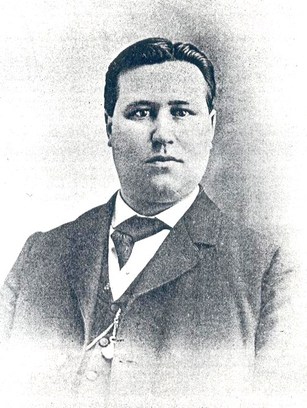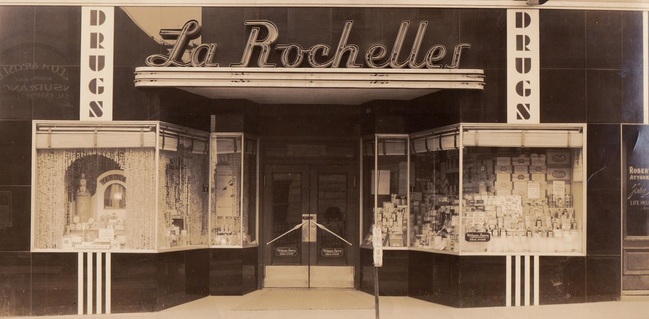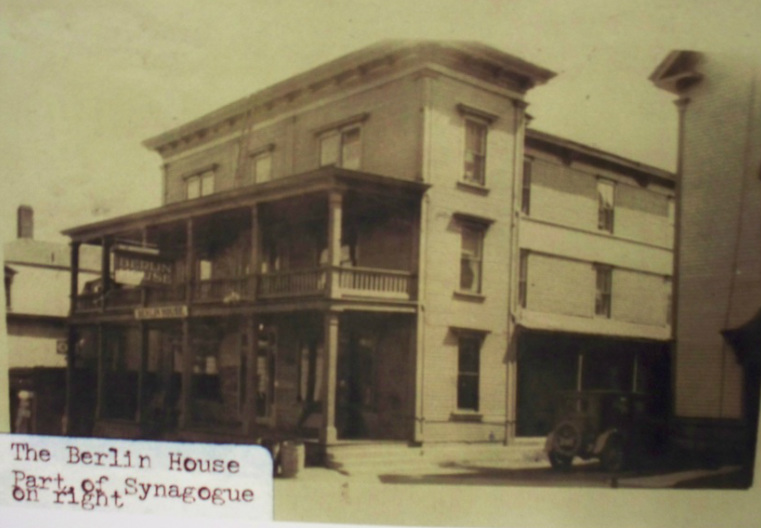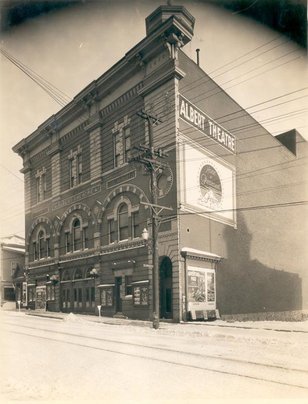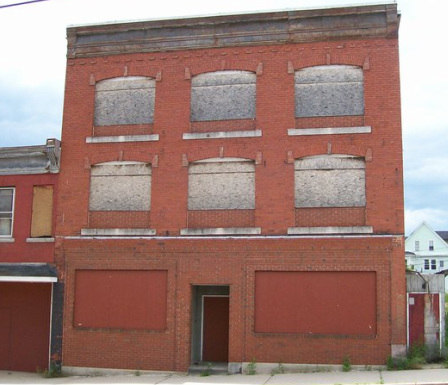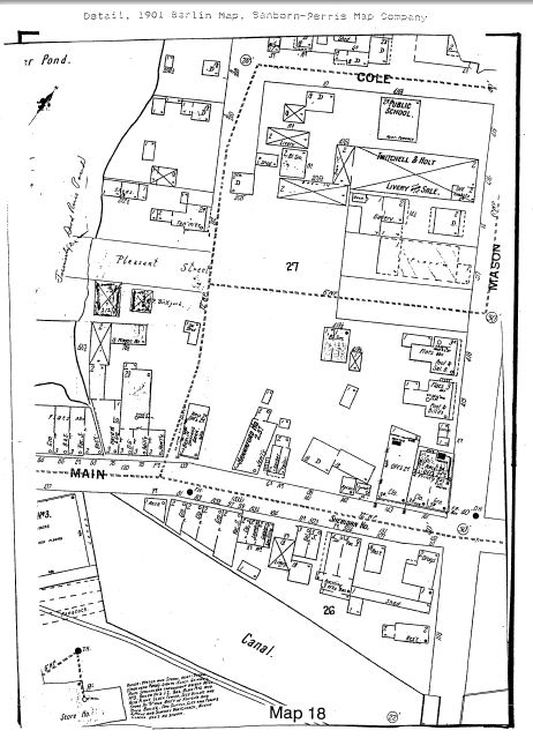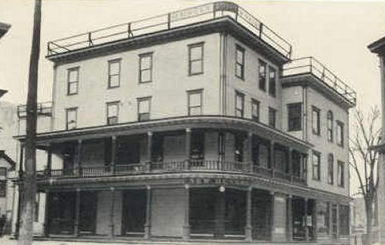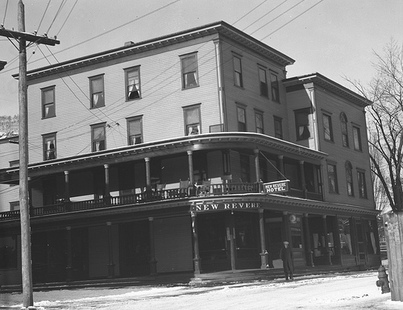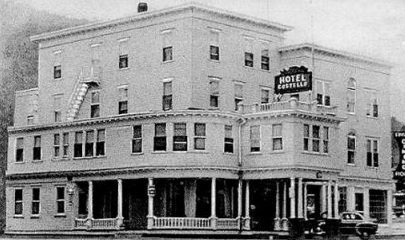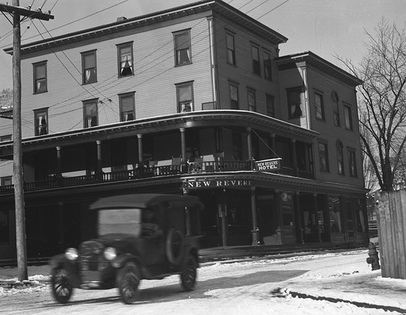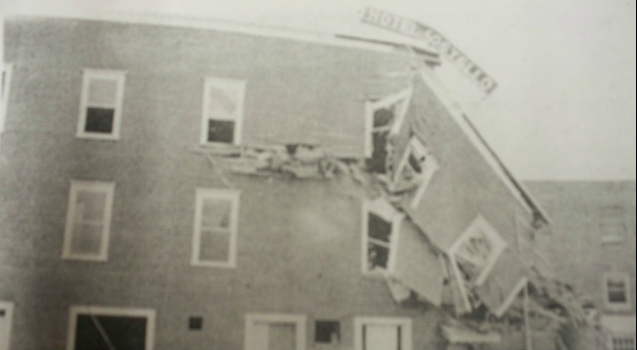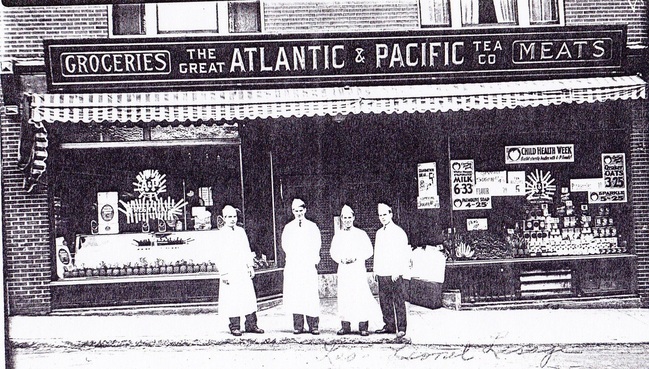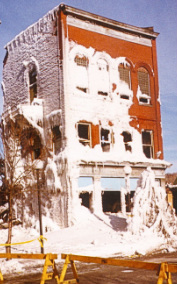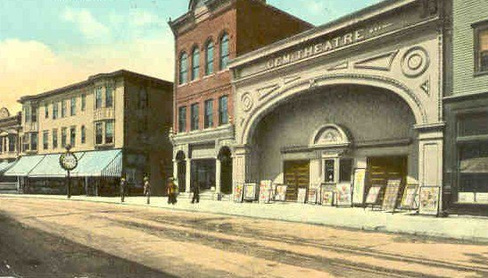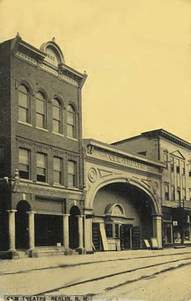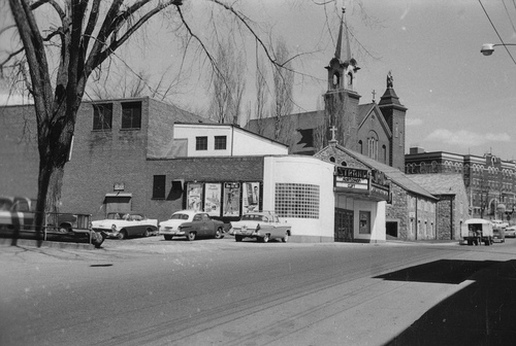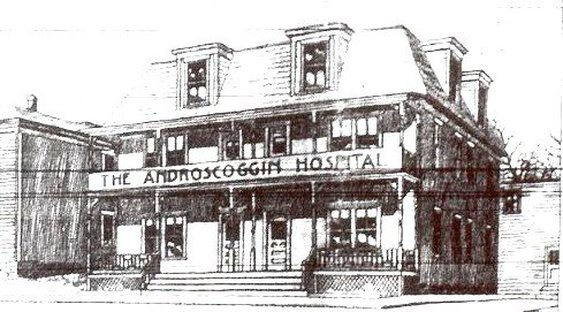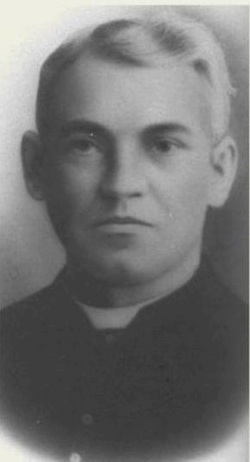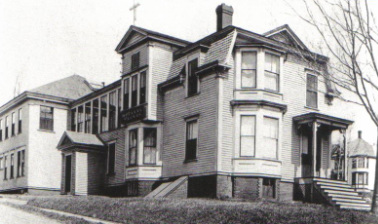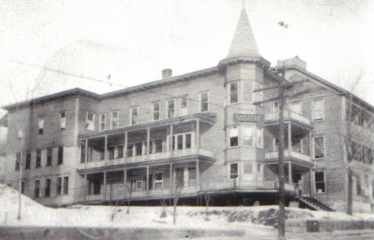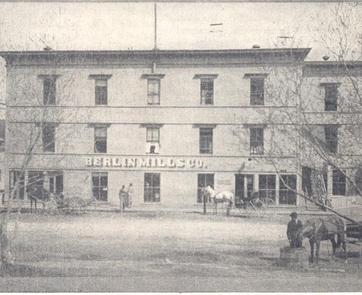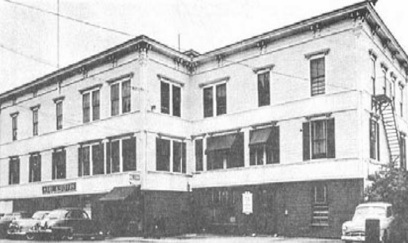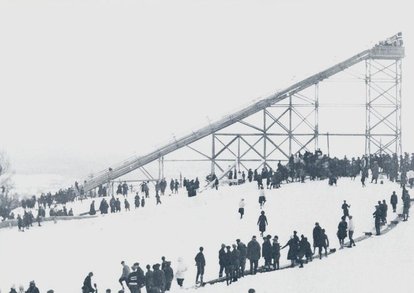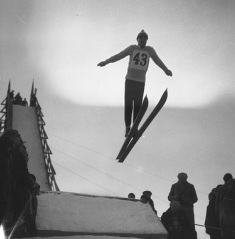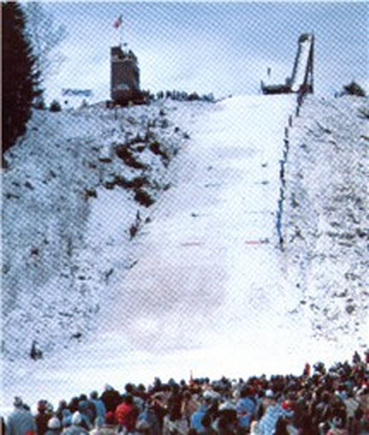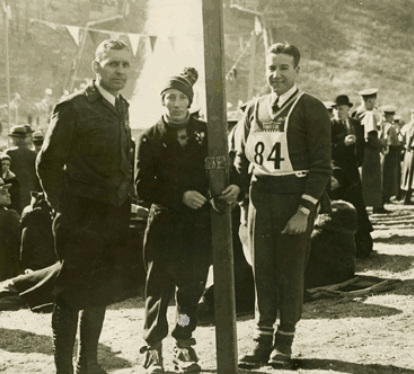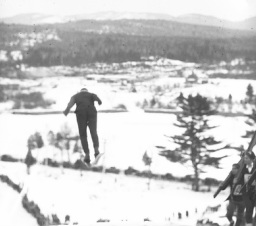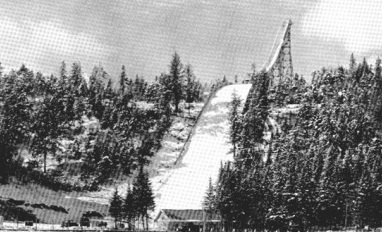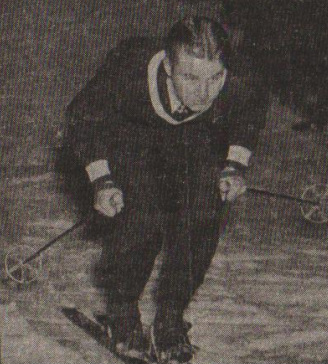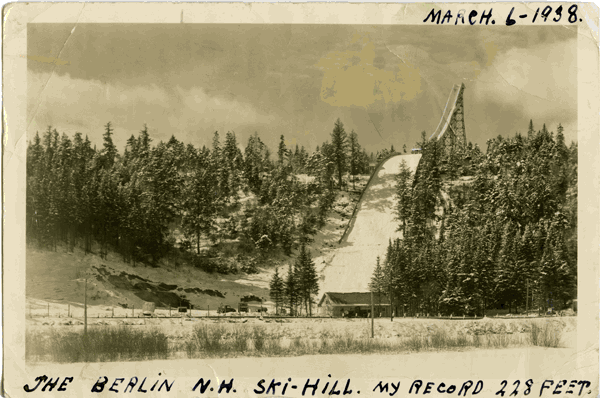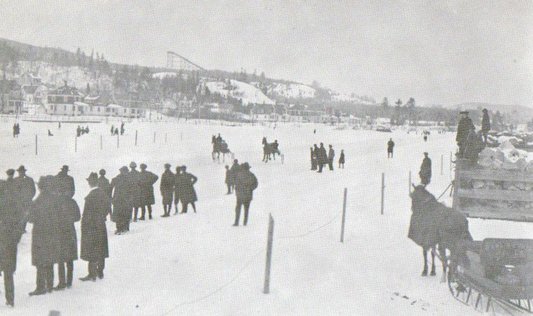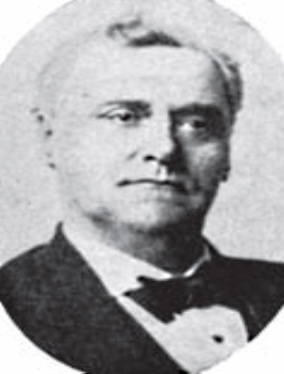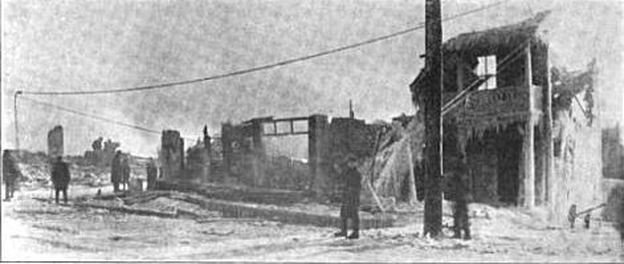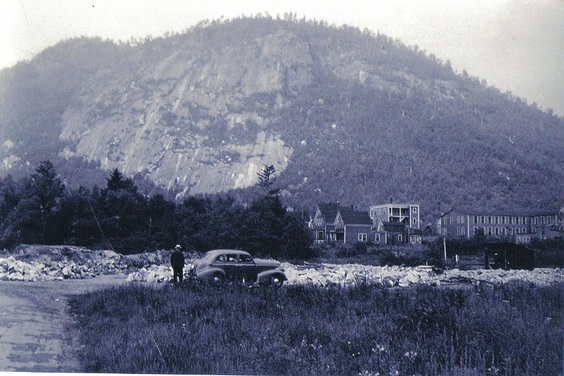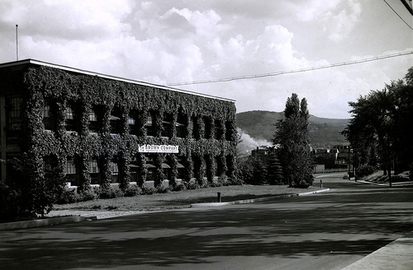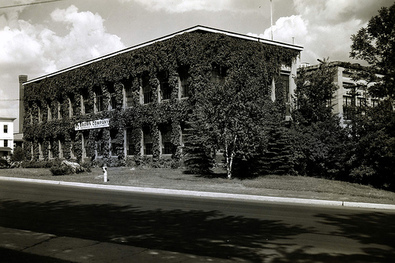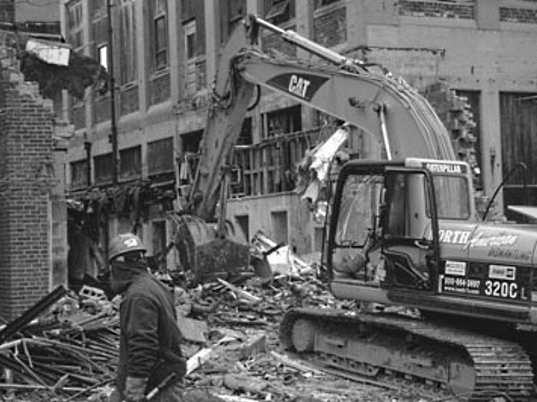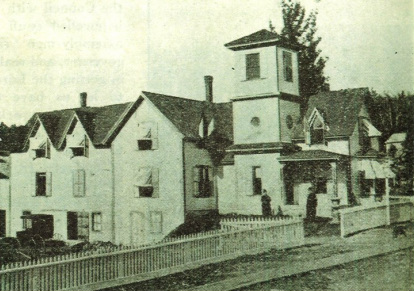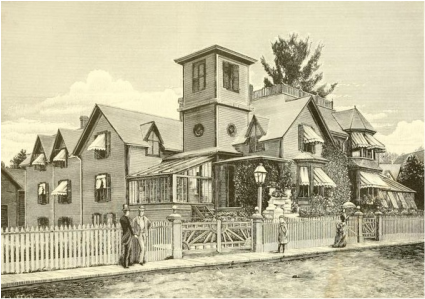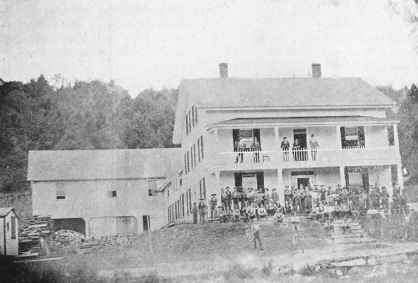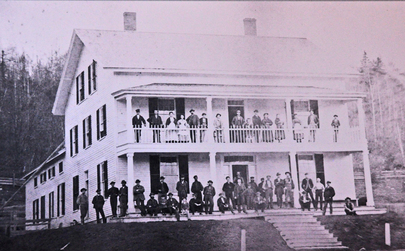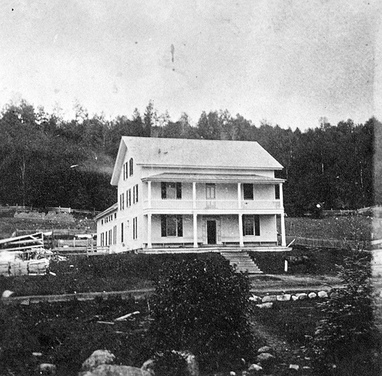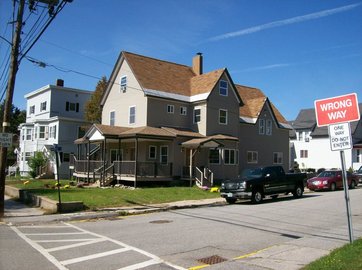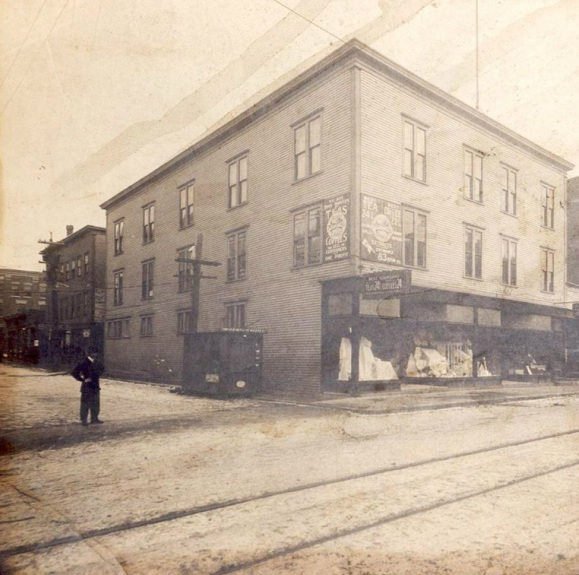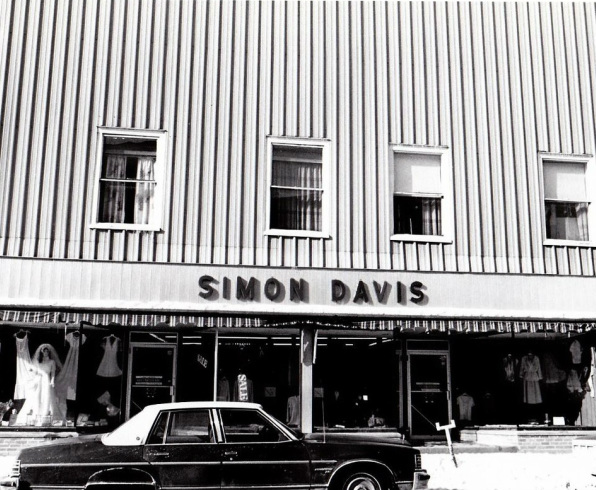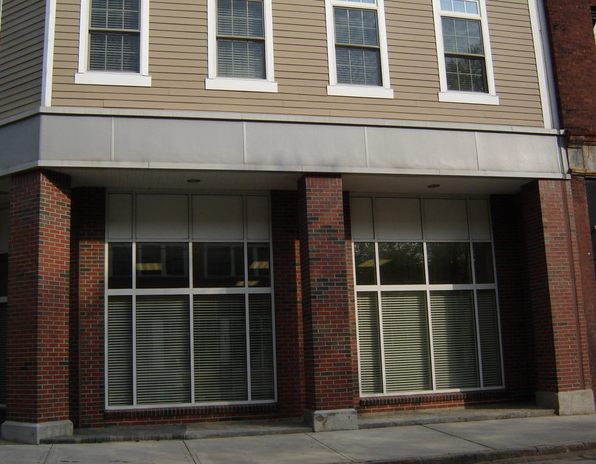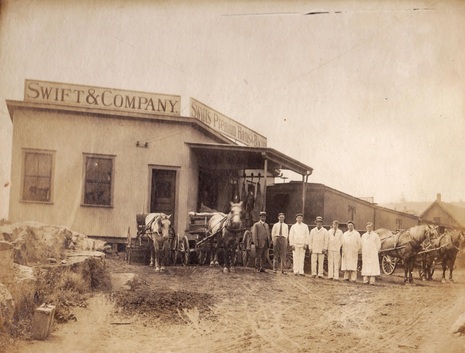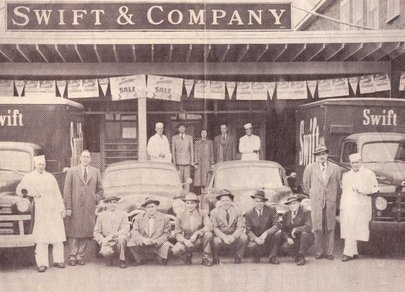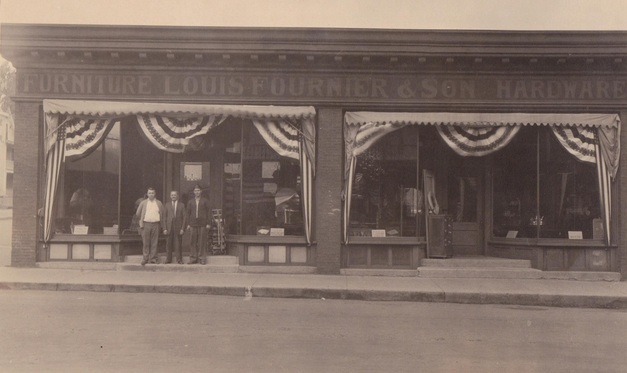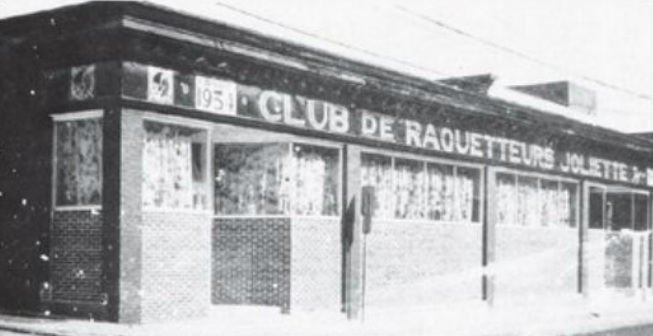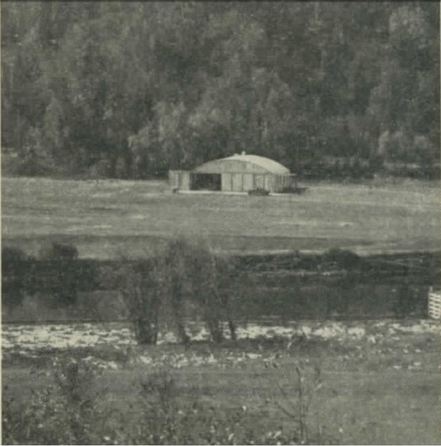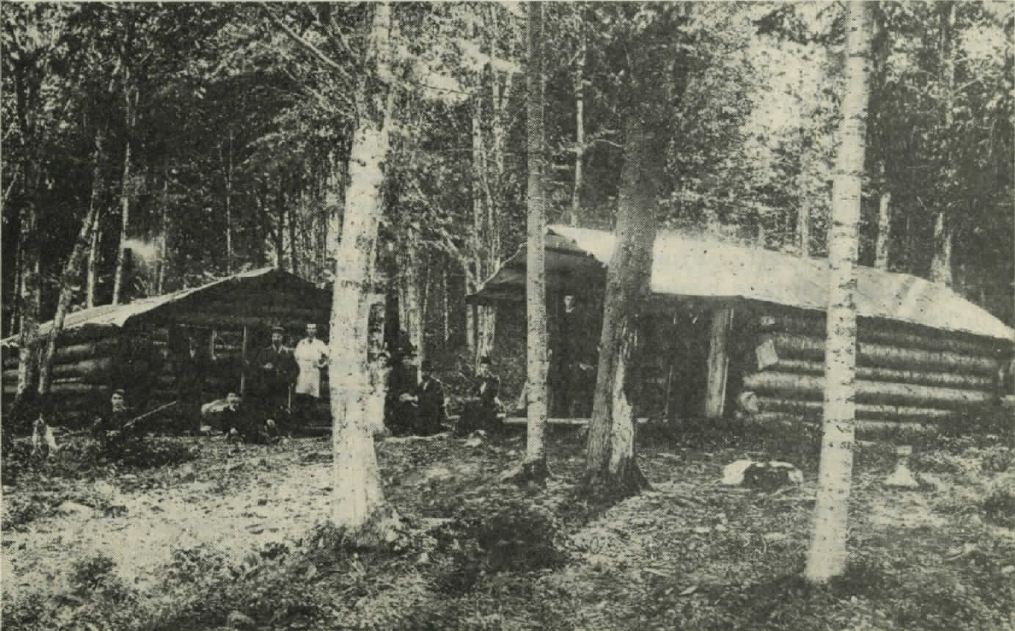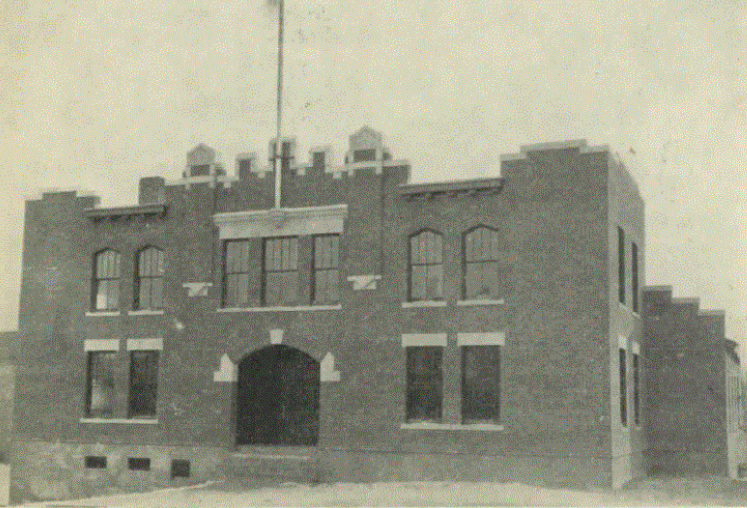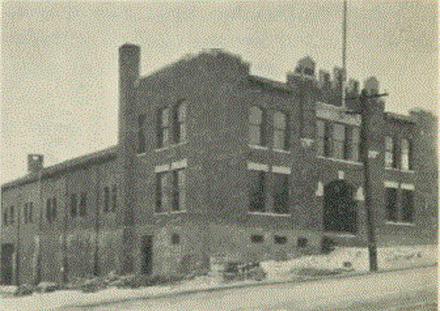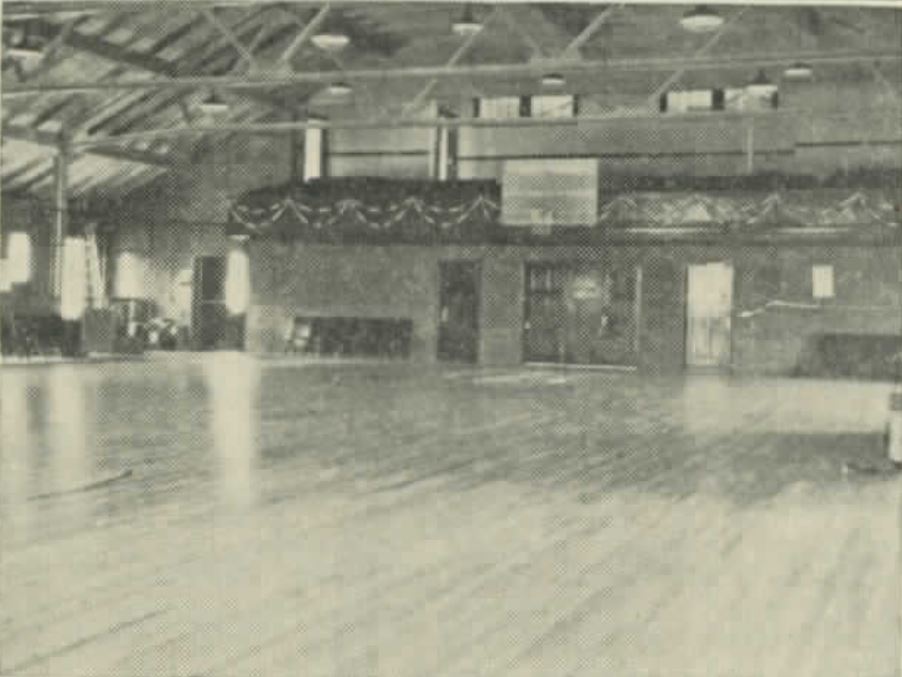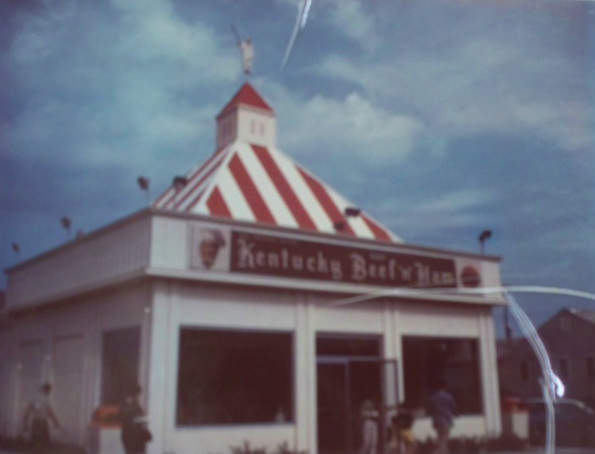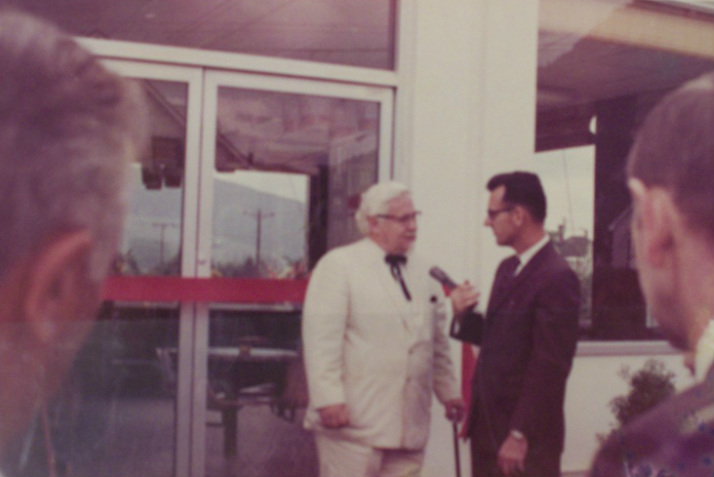Other Buildings and Landmarks
Berlin's Bars and Saloons
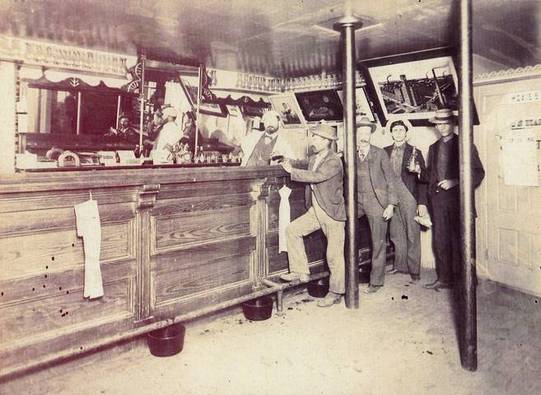
Theodore Morin's Saloon (Image from Poof Tardiff)
There are many other buildings and landmarks that deserve credit for Berlin's growth. Here is a story about Berlin's rougher times. The Rev. John B. Carruthers, who served as pastor from 1893 to 1901 at Berlin’s Congregational Church, was very against Berlin’s bars and saloons. People from outside of the area claimed that Berlin was the place for a good time without being interfered with by the law and he and his followers had enough.
The time came in 1900 when he was chosen to run for the office of mayor. At very lowest estimate, Carruthers believed that Berlin had, along with drug stores and hotels, thirty saloons whose business it was to sell liquor and gamble. The citizens had been told repeatedly and it was freely talked about on the streets, that these saloons were a financial asset to the city. The reverend said that a “Minister Mayor” might not know how to run the finances of this city, but he could find a cheaper way to supply the citizens with liquor for medical or mechanical purposes.
The drug stores had the privilege to keep and use alcohol for medical reasons, but when this drug store became a common saloon, Carruthers believed it should have been treated as one. Caruthers did not win the election for the title of mayor but his dream did come true. Many of the bars were shutdown or only allowed to open for certain hours. Berlin lost the title of one of the most toughest cities in America but gained many other nicknames. the photo on the left shows the inside of one of Berlin’s bars in the early 1900’s the bar itself was on the lower east corner of Pleasant and Mason Streets and it was run by Theodore Morin.
During prohibition, the greatest seizure of alcohol in this state was made on August 21, 1920 here in Berlin and was ordered by the city solicitor, Warren James. County officers seized $5,000 worth of the best liquor available at Hotel Albert, which was recently torn down (2012). At the time of the seizure, the building was owned by Doctor George A. St. Germaine, a surgeon dentist. The hostelry was located in a side room on the second floor. Two trips of the police patrol were required to remove the alcohol, which was then brought to the court house and temporarily held in a couple of cells. Dr. St. Germaine had anything from Scotch whiskey and Canadian club to fancy drinks like expensive wines. Dr. St. Germaine pleaded guilty and paid a fine of $100 and spent a month a jail.
The time came in 1900 when he was chosen to run for the office of mayor. At very lowest estimate, Carruthers believed that Berlin had, along with drug stores and hotels, thirty saloons whose business it was to sell liquor and gamble. The citizens had been told repeatedly and it was freely talked about on the streets, that these saloons were a financial asset to the city. The reverend said that a “Minister Mayor” might not know how to run the finances of this city, but he could find a cheaper way to supply the citizens with liquor for medical or mechanical purposes.
The drug stores had the privilege to keep and use alcohol for medical reasons, but when this drug store became a common saloon, Carruthers believed it should have been treated as one. Caruthers did not win the election for the title of mayor but his dream did come true. Many of the bars were shutdown or only allowed to open for certain hours. Berlin lost the title of one of the most toughest cities in America but gained many other nicknames. the photo on the left shows the inside of one of Berlin’s bars in the early 1900’s the bar itself was on the lower east corner of Pleasant and Mason Streets and it was run by Theodore Morin.
During prohibition, the greatest seizure of alcohol in this state was made on August 21, 1920 here in Berlin and was ordered by the city solicitor, Warren James. County officers seized $5,000 worth of the best liquor available at Hotel Albert, which was recently torn down (2012). At the time of the seizure, the building was owned by Doctor George A. St. Germaine, a surgeon dentist. The hostelry was located in a side room on the second floor. Two trips of the police patrol were required to remove the alcohol, which was then brought to the court house and temporarily held in a couple of cells. Dr. St. Germaine had anything from Scotch whiskey and Canadian club to fancy drinks like expensive wines. Dr. St. Germaine pleaded guilty and paid a fine of $100 and spent a month a jail.
La Rochelles Drug Store
The Odd Fellows Block
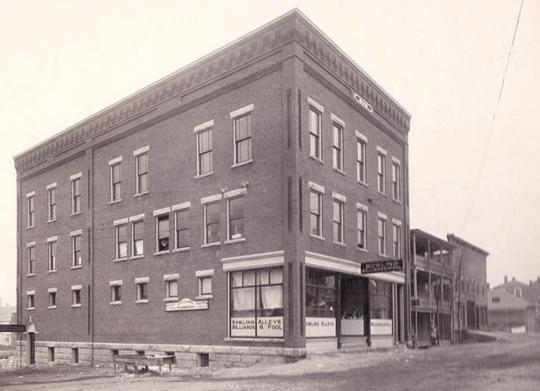
The Odd Fellows block was built on the southwest corner of Pleasant and Mason Streets in 1904. Many, many business operated out of this building from the time it was built until it was torn down during the Cole Street project in 1970. Even the Berlin Reporter operated in this building during its last years. (Image from Poof Tardiff)
The Berlin House
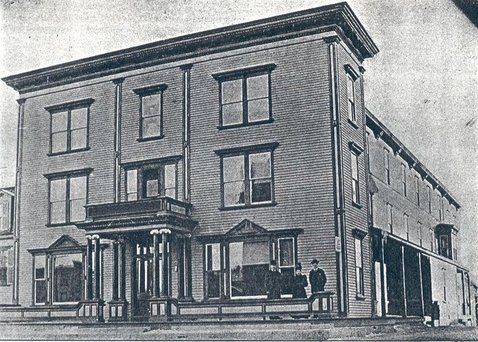
A photo showing the Berlin House back in it's heyday (Image from Poof Tardiff)
In 1888, Henry F. Marston, who later became Berlin’s first mayor, purchased land to build a hotel in Green Square. This hotel was called the Berlin House and before this there was just a barn that occupied this lot. With the construction of this new hotel, visitors to the early Berlin could sit on the front porch and watch the early Berlinites shop in the stores and go on with their lives. According to the Lakes and summer resorts in New Hampshire published by the State of New Hampshire in 1892, the Berlin House could hold a maxim of 75 people and charged $2.00 a day, but if you stayed for a week, you would pay $7 -10 dollars.
Fifteen years pasted under the ownership of Mr. Marston and in 1903, the Berlin House was sold. After 1903, the Berlin House changed owners frequently and on August 19, 1961, this famous hotel burnt to the ground. The lot where the Berlin House once stood now sits empty next to the Heritage Baptist Church, which is across the street from the Eagle’s Club.
Fifteen years pasted under the ownership of Mr. Marston and in 1903, the Berlin House was sold. After 1903, the Berlin House changed owners frequently and on August 19, 1961, this famous hotel burnt to the ground. The lot where the Berlin House once stood now sits empty next to the Heritage Baptist Church, which is across the street from the Eagle’s Club.
The Bell Block
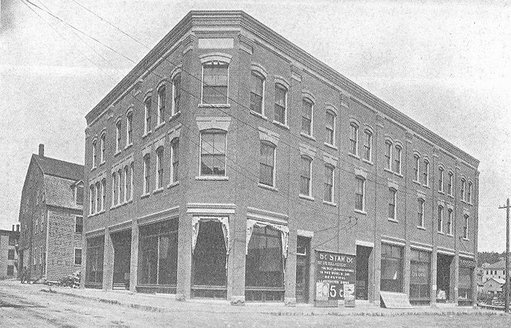
(Image from Poof Tardiff)
The original Bell Block building was built by J. Fred Bell in 1909. By 1911, the building burnt down and a new building was built by 1912. These buildings stood where the parking lot across from today’s Gold House Pizza. Before the 1970’s Cole Street housing project, Mechanic Street ran down all the way to the railroad tracks of the Grand Trunk Railroad.
The Albert Theaters
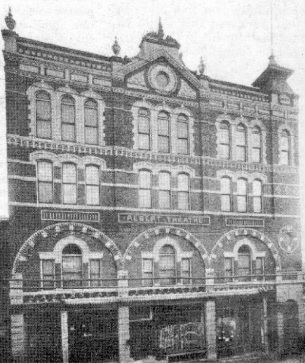
The first Albert Theatre building (Image from Poof Tardiff)
The original Albert Theater building was built in 1905 by Albert Croteau, who was also a barber in Berlin. It could seat 1,400 people. In January of 1906, this building was ready and had its grand opening ceremony. It was only open for a little over a year when this building was completely destroyed by a fire on November 3, 1906. Luckily fire did not stop Mr. Croteau’s dream to build a theatre and he applied to rebuild on the same spot as the old one. The second theater was completed in March of 1910 but sadly in November of that same year, fire struck again. This fire did not destroy the new building it just need to be gutted and could be reopened. By January 29, 1911 the Albert Theatre was up and running again and was ready for more spectators.
The Croteau Block
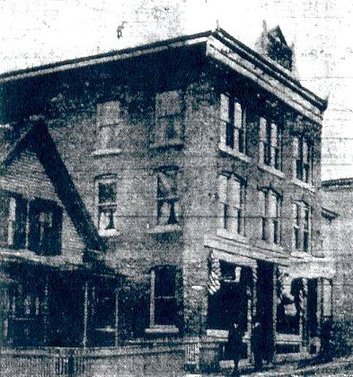
The Croteau Block (Image from Poof Tardiff)
The Croteu Block was built in 1903 by the same man who built the Albert Theater, Albert Croteau. When it was first built, it was used as a small hotel called “Hotel Albert” but near the end of this building’s life, it housed many different businesses. “Hotel Albert” still stands on Main Street one hundred and eight years after it was built. This building stands a little ways northwest of the vacant Albert Theater.
*This building was torn down around 2011.
*This building was torn down around 2011.
The Revere House
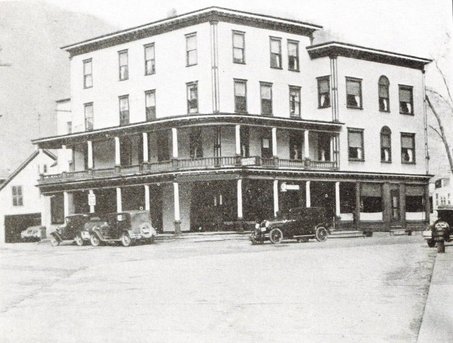
The Revere House (Image from Poof Tardiff)
The Revere House was built in the mid 1890’s on the site where Daniel Green once had a small store which opened in the 1850’s. In 1904, this building was remolded by Foss T. McNally and the name was changed to the New Revere House. In 1931, William F. Costello purchased the New Revere House and was called the Hotel Costello. Ownership changed again when J. Roland Champoux purchased the hotel in 1948. He remained the owner of Hotel Costello, under the name Costello Motor Inn, until it closed in 1973. Today a Dunkin Donuts operates on the same spot as this famous hotel once did.
Atlantic and Pacific Tea Company (A&P)
The Berlin Savings Bank and Trust Company
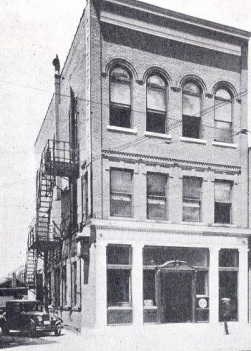
(Image from Poof Tardiff)
The Berlin Savings Bank and Trust Company was founded in 1890 and at that time stood on the “Square” in the Mason Block. The Mason Block was situated where the Northway Bank is today. A new building was built on Main Street in 1900, right at the beginning of where the Rite Aid building stands today. It was across Bickford Lane from the old Woolworth’s (Family Dollar), and next door to the Gem Theatre. A fire in the early 1990’s destroyed this area.
The Gem Theatre
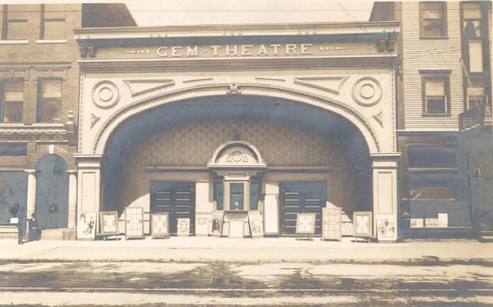
(Image from Poof Tardiff)
The Gem Theatre was Berlin’s second theatre, the Albert being the first. This theatre was built on almost the same spot as the Mt. Forist House once stood. It was built in 1909 and lasted about fourteen years as a theatre. It was converted into bowling alleys
and then by 1924 it became the JJ Newberry store. A fire destroyed it in 1930 and it was rebuilt, lasting until about 1968. By then a new business was listed as being on 135-137 Main Street. It was called Days Jewelry and Appliance store. This area was destroyed by a fire in the 1990’s and later became the Rite Aid store, which is
now empty.
and then by 1924 it became the JJ Newberry store. A fire destroyed it in 1930 and it was rebuilt, lasting until about 1968. By then a new business was listed as being on 135-137 Main Street. It was called Days Jewelry and Appliance store. This area was destroyed by a fire in the 1990’s and later became the Rite Aid store, which is
now empty.
The Strand Theatre
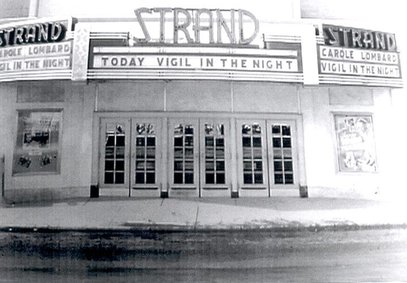
(Image from Poof Tardiff)
The Strand Theater was built in 1937 and opened its doors to the public at 8.00 pm on October 28, 1937. The first movie was “Heidi” starring the great Shirley Temple. There were almost 1,000 people present for this showing. The Strand closed its doors in November of 1961 and is called the Berlin Bowling Center today.
The Star Bakery
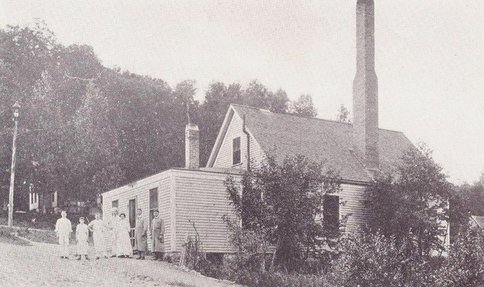
(Image from Poof Tardiff)
The Star Bakery was situated on the corner of Seventh and Denmark Street. There is an empty lot there today. The bakery was started by G. Gunnerson in 1907. From a small beginning, Mr. Gunnerson built a large and flourishing business, calling his product “Starcream Bread”. When his business was at its peak, ten people were employed here. His product was shipped to all sections of the city and further. Modern wax paper was used to ensure the freshness of his product.Bottom of Form
The Office for the International Paper Company
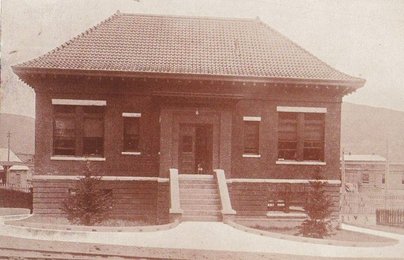
(Image from Poof Tardiff)
The office for the International Paper Company was built in 1906 and was situated on Glen Avenue just before the entrance into downtown Berlin. A timekeeper’s booth occupied the center of the basement, beside which all had to pass to the card racks designated for their respective departments. The cards were brought to their working area and the process was reversed at the end of the shift. Every day, over 600 men passed through this office. A businesses called Great Looks now operating in this building today.
The Androscoggin Hospital
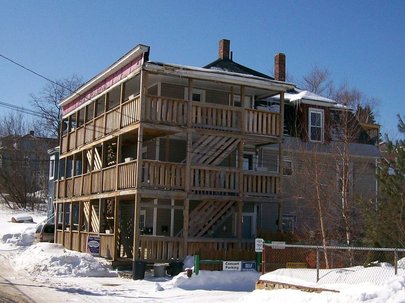
Back in the late 1800’s and early 1900’s, when someone got injured, no matter how seriously, they were brought to their homes. If they did not own a home, they were taken to a friend or relatives. A doctor was called and where every they stayed became the hospital. The first hospital in Berlin was St. Luke’s Hospital on Glen Ave. and was opened in July in 1889, but not too much information is known about it. On November 2, 1894, a meeting was held and the Berlin Hospital Association was formed to establish a suitable place for a hospital. The St. Luke’s chapter and St. Barnabas Guild voted to merge and turn over all the money that had accumulated since 1888, just for this cause.
The members of this new association were, Mrs. H.J. Brown, Mrs. W.H. Gerrish, Mrs. A.T. Causier, Mrs. R.N. Chanberlin, Mrs. H.E. Oleson, Mrs. A.P. Lavalle, Mrs. F.A. Colby, Mrs. James Goodwin, Mrs. C.C. Gerrish and Ms. Sarah Wardwell. By January of 1895, a place and name were chosen for a new hospital. The name was “The Androscoggin Hospital” and the location was the home of Mrs. Davies on what was then called Stearns Street, which is now First Avenue.
The first floor had a kitchen, dining room, sitting room, reception room, and an office. It also had a reading room and library. The second floor had two private rooms, two wards with two cots each and a large bathroom. Also found on the second floor was an operating room and a private ward off this room. The third floor had eight private rooms, which could be fitted in case of emergencies. All patients were admitted, male or female, except for those who were suffering from mental illness and contagious diseases.
In 1902 The Androsscogin Hospital was remodeled and updated. Everything was put in first class condition This building still stands, although remolded, on 644 First Ave. It is opposite from the Recreation Center. Another emergency hospital was located in the home of Dr. J.J. Cobb on 3 High Street. It had six beds and was only used for emergences cases. Either this building no longer stands, or the number changed because there is no residence in Berlin today (2012) known as 3 High Street.
The members of this new association were, Mrs. H.J. Brown, Mrs. W.H. Gerrish, Mrs. A.T. Causier, Mrs. R.N. Chanberlin, Mrs. H.E. Oleson, Mrs. A.P. Lavalle, Mrs. F.A. Colby, Mrs. James Goodwin, Mrs. C.C. Gerrish and Ms. Sarah Wardwell. By January of 1895, a place and name were chosen for a new hospital. The name was “The Androscoggin Hospital” and the location was the home of Mrs. Davies on what was then called Stearns Street, which is now First Avenue.
The first floor had a kitchen, dining room, sitting room, reception room, and an office. It also had a reading room and library. The second floor had two private rooms, two wards with two cots each and a large bathroom. Also found on the second floor was an operating room and a private ward off this room. The third floor had eight private rooms, which could be fitted in case of emergencies. All patients were admitted, male or female, except for those who were suffering from mental illness and contagious diseases.
In 1902 The Androsscogin Hospital was remodeled and updated. Everything was put in first class condition This building still stands, although remolded, on 644 First Ave. It is opposite from the Recreation Center. Another emergency hospital was located in the home of Dr. J.J. Cobb on 3 High Street. It had six beds and was only used for emergences cases. Either this building no longer stands, or the number changed because there is no residence in Berlin today (2012) known as 3 High Street.
The St. Louis Hospital
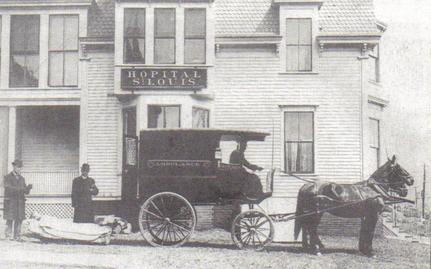
The St. Louis Hospital was named after Father Louis Laplante. Four Sisters of Charity from St. Hyacinth in Quebec came to Berlin to staff the new hospital. Many additions were made on this building until what we see today came about. The hospital ended its affiliation with the Sisters of Charity to become a non-profit organization in 1971. They changed the name to the Androscoggin Valley Hospital and built the new hospital that we have today.
Lefebvre and King
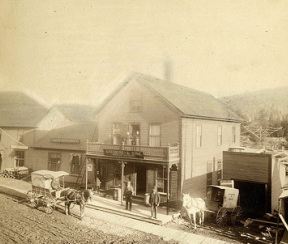
(Image from Beyond Brown Paper)
According to “The Leading Business Men of Berlin Falls” in 1890, this establishment dealt in fresh and salt meats, smoked goods and eggs. They were an agent for Rumford Creamery. Operations were begun in 1888 by Sheridan and Lefebvre, King replaced Sheridan in 1889.This building still stands south of Tony's Pizza on Main Street, although remodeled. Tony's would be where the building on the left of Lefebvre and King in the photo.
The Brown Company Store
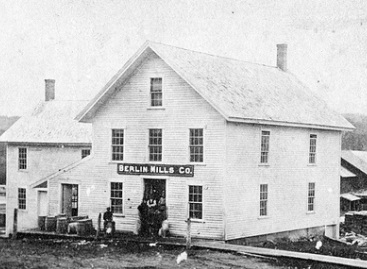
The Berlin Mills Company Store in 1870, latter called the Brown Company Store
The Berlin Mills Company Store was built in 1853 and started selling dry goods. It was known as the Company Store and was directly across the street from today’s Brown Company House. After Mr. W.W. Brown bought out the Winslow Company sawmill, it was known as the Berlin Mills Company Store. In the 1917, this store once again changed names and became the famous Brown Company Store, serving all of this company’s employees. After closing in 1945 and serving the company for ninety two years, the vacant building was turned into a company called “Ware Knitters of New Hampshire”. This business lasted until the late 1960’s and the building once again became empty. The last business to operate here before it was torn down and turned into a parking lot was Milan Footwear Company. They closed in 1974, the structure was demolished and a parking lot with the replica of a Boom Pier sets in the same place today. (Image from Beyond Brown Paper archives)
The A&P Market
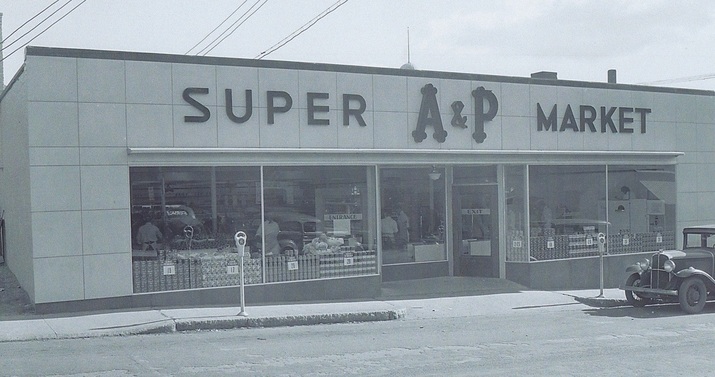
This photo shows the A&P Market, that was on the corner of Mason and Pleasant, in the 1920's or 30's. This store eventually was bought by Fred Prince and became Prince’s Supermarket. Notice the car going "up" Pleasant Street, one-way traffic on this street didn't come until 1948, as well as Main Street. This building was torn down this year (2012) and is now an empty lot
The Nansen Ski Jump and Ski Club
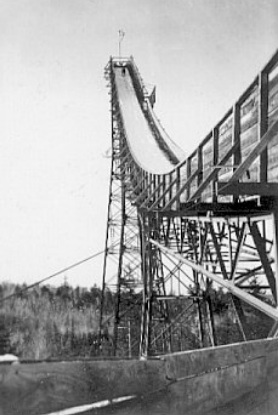
Photo taken by Clement Cusson, 1938
The oldest ski club, still in existence, in the United States began in Berlin in 1872. The original name of this club was the Berlin Mills Ski Club. It was also called the Berlin Falls Club. Other names were also brought up, such as Skiklubben Nordamerikansk and the Fridtjof Nansen Club. Mr. Nansen was a hero for some of this club’s early members. Nansen was a great explorer and the first man ever to cross Greenland on skis. Nansen was the name that finally stood after being voted in at a meeting of its members in the early 1920’s.The first ski jump was the Paine Hill Ski Jump. The jump was located to the north of the section of town called “The Norwegian Village” that was called Paine’s Pasture.
The jump was situated on the top Paine's Hill of (Sherry Street). A storm tiped over this jump and then, in 1936, the new jump was constructed. This 80 meter jump has a 171.5 foot tower, a 225 foot vertical drop, and a descent angle of approximately 37.5 degrees. For almost fifty years this was the largest ski jump in the eastern United States and the foremost jump in the country. This was the site of most all major championship ski jumping competitions, as well as many Olympic tryouts. The first person to go off the new jump was a man by the name of Clarence “Spike” Oleson. As for women skiers in the 1920’s and 30’s, regional ski heroes became more popular, such as the Graves sisters here in Berlin. A Norwegian woman named Johanne Kolstad caught the eye of worldwide news when she achieved 228 feet off the Nansen Ski Jump in 1938.
The jump was situated on the top Paine's Hill of (Sherry Street). A storm tiped over this jump and then, in 1936, the new jump was constructed. This 80 meter jump has a 171.5 foot tower, a 225 foot vertical drop, and a descent angle of approximately 37.5 degrees. For almost fifty years this was the largest ski jump in the eastern United States and the foremost jump in the country. This was the site of most all major championship ski jumping competitions, as well as many Olympic tryouts. The first person to go off the new jump was a man by the name of Clarence “Spike” Oleson. As for women skiers in the 1920’s and 30’s, regional ski heroes became more popular, such as the Graves sisters here in Berlin. A Norwegian woman named Johanne Kolstad caught the eye of worldwide news when she achieved 228 feet off the Nansen Ski Jump in 1938.
The Clement Block
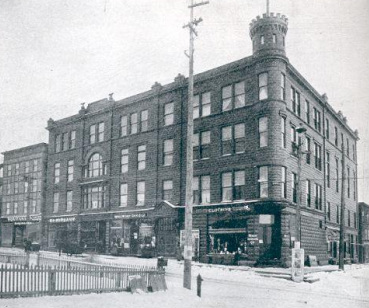
(Image from Poof Tardiff)
The Clement Block, also know as the Clement Opera House, stood on the same corner as Gallus and Green today. This structure was built by Fred M. Clement in 1894. Clement was Berlin’s fourth mayor. When completed a year later, this building contained 11 stores and an opera house, which could seat hundreds of people. It also had apartments on the top floor. On January 4, 1905, at 9:30 pm, this structure caught on fire, cutting off the people on the top floor. A baby was thrown from the top floor and caught by patrolman Malcolm Shorey. The mother jumped, but did not survive. The fire wiped out all of the buildings towards the river and several up Main Street. This lot
remained vacant until 1917, when the U.S. Post Office was built on the same spot.
remained vacant until 1917, when the U.S. Post Office was built on the same spot.
New Hampshire Town Stricken, With Thermometer Below Zero
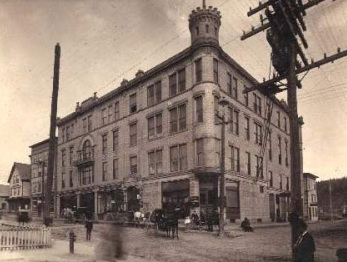
Berlin, N. H., Jan. 5. A fire that was fought from 9:15 o’clock last night until after 2 o’clock this morning destroyed Clement’s Opera House block, the two Gagnon blocks, the Thorndike hotel, Brooks drug store, three storehouses and a stable and threatened the entire business section of the city. The total loss is placed at $150,000. During the fire many lodgers leaped from the fourth story of the Opera House block, sustaining in several instances broken limbs and other serious injuries. Mrs. Frank Wright, one of those who jumped, was picked up insensible and is in a dangerous condition, with a chance of her recovery. She missed the net which had been placed by the firemen and struck on the frozen ground. Her husband, Frank Wright, is perhaps fatally hurt. The fire originated in the Opera House block from an unknown cause and had a good start before it was discovered. Early in the fire the electric light wires were broken down, leaving the city in darkness save for the flames and adding to the confusion. The night was bitter cold, with the thermometer below zero. -The Fitchburg Sentinel, Fitchburg, MA 5 Jan 1905
The NYA Machine Shop
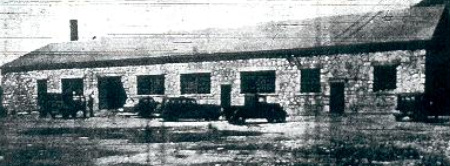
The NYA machine shop was built in 1942 by the National Youth Administration. At the time, this building was the very last thing on the end of Willow Street because the Memorial Field had not been built yet, and would not come about for about another seven years. Alf Halvorson, Berlin’s NYA director, said that while working with the youth on projects up to this time, he visualized the need for some type of a trade school. Here, the youth could not only make essential parts to help the government in the war effort, but also train themselves to be in direct demand for private industry. Alf got in touch with higher ranking men in the district, who understood what was needed for such a shop. He then submitted these plans to the proper authorities, and was granted permission to move forward with his idea. Under the supervision of two masons, the rock was quarried out by the young people. Even though this was a difficult project, the youth workers completed it in record time. Today this building still stands but not as a machine shop, but as a Christian place of worship.
The Brown Company Research and Development
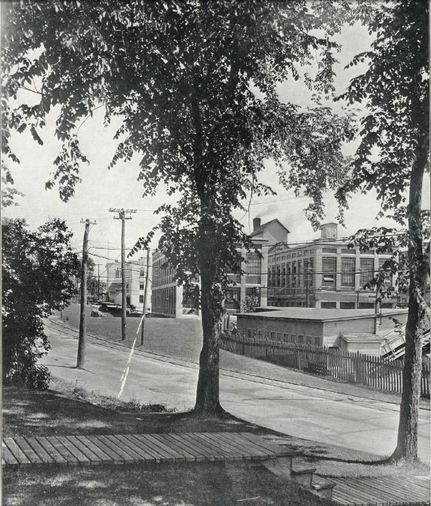
The Research and Development, 1924
The Brown Company Research and Development building was built to make new products for the Brown Company to use in their mills and improve the life of their workers. The Brown Company had the best chemists working in these facilities. One building was for research and the other for development. These buildings remained separate for many years but eventually a central section was but in. When American dismantling started to tear down the mill, the also took down this central section. (Image from Poof Tardiff)
The Elks Home
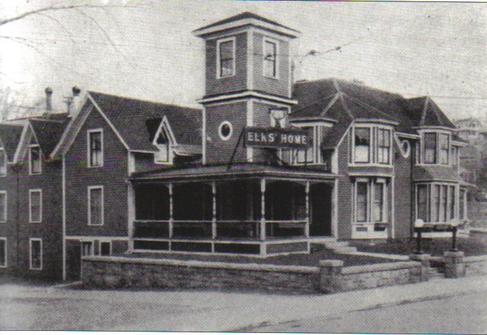
The Elks Home
Before 1880, Mr. Ellis owned a small house on the corner of High and Main Streets but in that year Henry H. Furbish purchased the house and tore it down. Mr. Furbish built a handsome residence. In 1898, Abraham M. Stahl bought the house but by 1924 it was a lodge owned by the Elks club. The name was changed to the Moose Lodge in 1934. In 1937, the Moose Lodge was torn down and the Strand Theatre was built (today’s bowling alley).
The Berlin Mills Pool
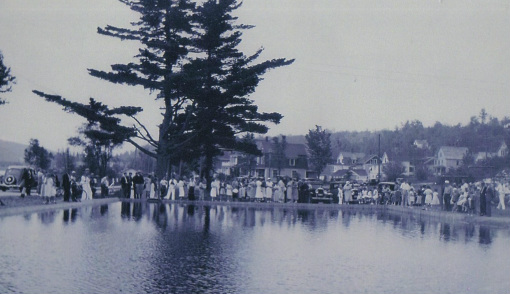
(Image donated)
The Berlin Mills Pool was built by the National Youth Administration on the corner of Main and Eleventh Streets. Constriction of the pool started on May 19, 1936 and when finished was 70 feet long and 80 feet wide and had a depth from two to seven feet deep. Officials of the National Youth Administration and the city of Berlin were present at the opening of the new public pool, on July 4th, 1936, at ten o’clock in the morning. Both Donald Henderson and Geraldine Pinette spoke for the younger boys and girls who built the pool. Miss Pinette was the first person to swim in the pool.
The A.W. Walters Block
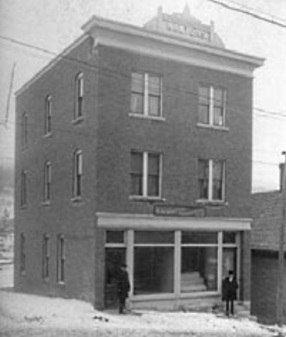
A.W. Walters Block (Image from Poof Tardiff)
The A.W. Walters Block was built in 1904 and was used for undertaking rooms by the undertaker A.W. Walters. This building once stood next to the Berlin Public Library but now sits empty with a fence around the area where the building once stood.
The Fleury-Patry Funeral Parlor
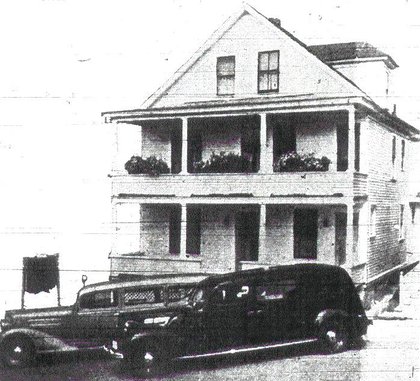
The Fleury-Patry Funeral Parlor in 1939 (Image from Poof Tardiff)
Alfred Ruel went into business with Oscar Fleury and started doing business in the home of Mr. Ruel. They called this business the Fleury-Patry Funeral Parlor. Latter bought another funeral parlor on Burgess Street. Mr. Fleury went on his own and established at the corner of High and School Streets. The Fleury-Patry Funeral Parlor still stands at 95 Hillside Avenue about three houses up from Bob’s store and is no longer a funeral parlor.
Confectionary store
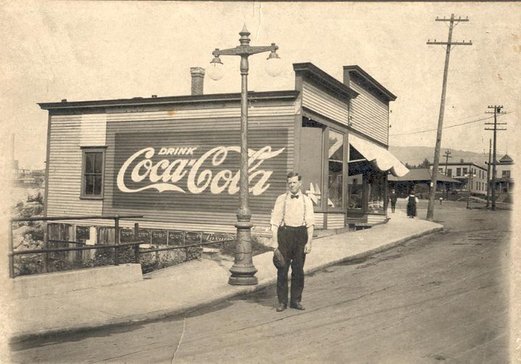
A photo taken in 1922 of the Confectionary store on East Mason Street with Mr. J.B. Marcou in front of it (Image from Poof Tardiff)
Mr. J.B. Marcou owned two stores, one on Goebel Street, and the other on East Mason Street. The store on East Mason Street stood on the spot where the entrance to the Community Field is today.
The H. Wertheim Clothing Store
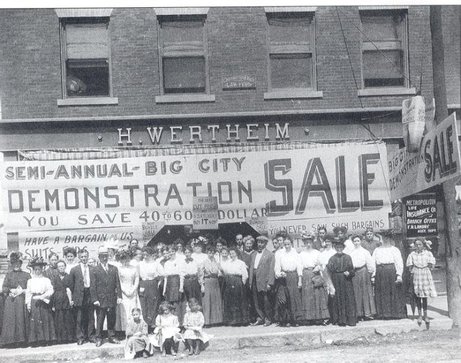
The H. Wertheim building on their grand opening (Image from Poof Tardiff)
The H. Wertheim clothing store was built in 1897 and had their grand opening on Saturday December 11, 1897. The building also housed an insurance firm, a lawyer’s office, and a dentist’s office. Today this building houses Morin Shoe Store and Inner Glimpse.
The Brown Company House
Doctor Lavallee’s office
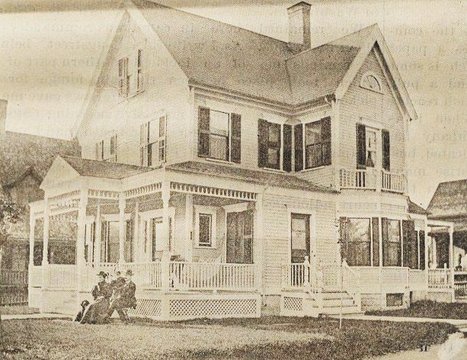
Doctor Lavallee built his home in 1895 and like most doctors at that time; he had his office there as well. This building still stands on the corner of Church and Pleasant Streets. Another doctor also lived in this home as well, his name was Normand Couture.
Morin’s Pastry Shop and Luncheonette
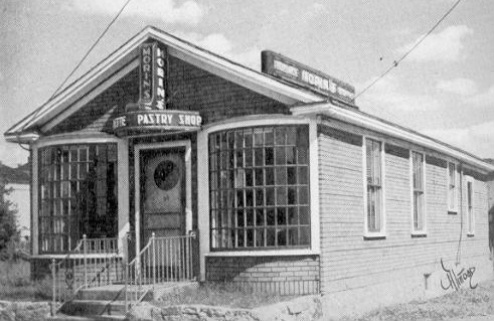
Morin’s Pastry Shop and Luncheonette
Morin’s Pastry Shop and Luncheonette was owned and operated by Joseph Morin. The business operated from the late 1940’s to the late 1950’s. This building still stands on the corner of Willow and Park Streets, having its entrance at 98 Park Street. (Image from Poof Tardiff)
The Stahl-Clarke Company Block
Swift & Company
Fournier Furniture and Hardware Store
Blanchard and Twitchell Railroad
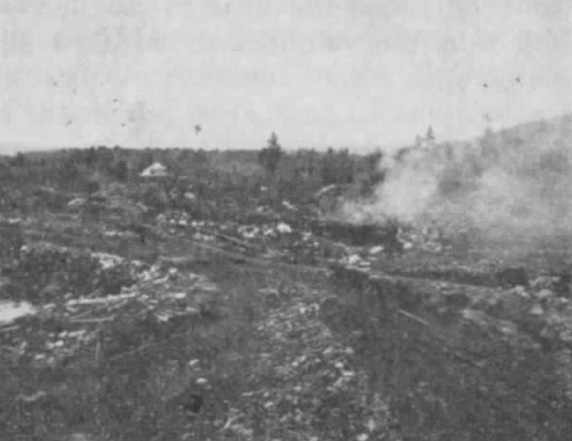
This photo is of the construction of the Blanchard and Twitchell Storehouse, taken by William E. Corbin in 1892. George W. Blanchard and Cassius M.C. Twitchell, having purchased large amounts of land in Riley and Grafton, Maine and also in Success, wanted to construct a railroad that connected their lumber business with the market. Construction began in the early part of 1892. At one time, these two men owned most of Success and from 25 to 30 million was there yearly output. They had two heavy locomotives, and one light one. It was not uncommon to see a train of 20 cars, each car carrying 10,000 feet of lumber. They erected a large building in which the first floor was used as a depot, a store, and the company offices. The upper part of the building was the loading house. This building was equipped with the best technology for its time including a telephone.
Berlin Municipal Airport
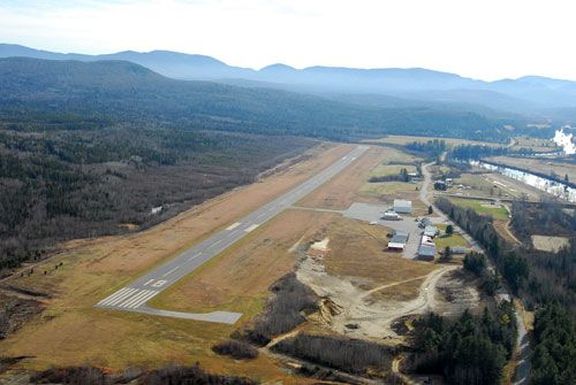
The first Berlin Municipal Airport, which was a simple dirt runway, occupied the site of what is now called the Nansen Wayside Park. This airport was used from the early 1920s until 1936, when it was used as a parking lot for the Nansen Ski Jump. In October of 1942, the current Berlin Municipal Airport was made. About 100 officials from Berlin and Milan, along with state and federal agencies attended the opening ceremonies. Mayor Tondreau made the opening remarks and paid tribute to the following men; WPA administrator James P. Quinn, City Solicitor Aruthur J. Bergeron, and City Engineer P. L. Murphy. The cost for building this runway was $500,000. (Image from www.berlinnh.gov)
Roscoe Mason Sporting Camps (Success Pond)
Paquette Motors
Berlin National Guard
The history of the National Guard in Berlin starts on April 19, 1906. Its roster contained 51 names. Among these were 24 veterans of the Spanish-American War and four veterans of the Second Boer War. A nearly complete roster of the prginal organization was as follows:
Capt. Oscar P. Cole, Commanding; First Lieutenant, George F. Cullett; Second Lieutenant, Allison C. Gorhatn; First Sergeant, Irving D. Ward;
Sergeants, Sullivan, Campbell, McGoff, McCarthy; Corporals, Bronk, Hopkins, McLeod; Pritchard, Sheridan; Musicians, Dubey, Keroack; Privates, Archambault, Boles, Bean, Boiselle, Butcher, Bouford, Blackburn, Campbell, Campbell, Corrivcau, Cullen, Coolidge, Compagna, Day, Davidson, Dolan, Fearin, Fermette, Flanders, Grundy, Lapar, Letourneau, Henderson, Macnamee, McGuire, Michaud, Mullen, Oldham, Oleson, Oleson, Parks, Smith, Stewart, Stewart, Streeter, Sawyer, Witherbee, Witherbee.
At this time (1906), the only problem Berlin’s newly organized National Guard had was that they did not have an armory. The state build armories in Nashua and later at Laconia, but still Berlin went without. Company G drilled at first in the old Music Hall, then went to a place called the “Rollaway” on Pleasant Street and later at the Bell Hall on Mechanic Street.
Berlin was denied an armory until 1925. Construction on Berlin’s armory, which is now the Berlin Police Station and it was completed on February 3, 1927. The number of guest who attended the open ceremony was 1,200, which included Ex-Governor John G. Winant and many others, although Governor Spaulding could not attend. Although the National Guard in Berlin has been through many hard times, this organization has been around for almost 110 years (as of 2013).
Capt. Oscar P. Cole, Commanding; First Lieutenant, George F. Cullett; Second Lieutenant, Allison C. Gorhatn; First Sergeant, Irving D. Ward;
Sergeants, Sullivan, Campbell, McGoff, McCarthy; Corporals, Bronk, Hopkins, McLeod; Pritchard, Sheridan; Musicians, Dubey, Keroack; Privates, Archambault, Boles, Bean, Boiselle, Butcher, Bouford, Blackburn, Campbell, Campbell, Corrivcau, Cullen, Coolidge, Compagna, Day, Davidson, Dolan, Fearin, Fermette, Flanders, Grundy, Lapar, Letourneau, Henderson, Macnamee, McGuire, Michaud, Mullen, Oldham, Oleson, Oleson, Parks, Smith, Stewart, Stewart, Streeter, Sawyer, Witherbee, Witherbee.
At this time (1906), the only problem Berlin’s newly organized National Guard had was that they did not have an armory. The state build armories in Nashua and later at Laconia, but still Berlin went without. Company G drilled at first in the old Music Hall, then went to a place called the “Rollaway” on Pleasant Street and later at the Bell Hall on Mechanic Street.
Berlin was denied an armory until 1925. Construction on Berlin’s armory, which is now the Berlin Police Station and it was completed on February 3, 1927. The number of guest who attended the open ceremony was 1,200, which included Ex-Governor John G. Winant and many others, although Governor Spaulding could not attend. Although the National Guard in Berlin has been through many hard times, this organization has been around for almost 110 years (as of 2013).
The Willis Block
Built in 1906, this building was used as a roller skating rink called the "Rollaway." By 1910, this building came under the ownership of H.I. Goss, who was also a local lawyer in town. Along with his new manager W.W. James, they kept roller skating a top amusement in the city of Berlin. They played great music, and a competent instructor.
During their first week, they had a six-piece band, and a two-mile race between Victor Dumas and George Therriault. General admission was ten cents. It cost twenty-five cents for men to skate and fifteen cents for women. The Rollaway was a big hit in the early 1900’s. The "Rollaway" was a major source of local entertainment for many years. This building would later burn down in April 2004, leaving an empty lot on Pleasant Street that is still empty to this day (2014).
During their first week, they had a six-piece band, and a two-mile race between Victor Dumas and George Therriault. General admission was ten cents. It cost twenty-five cents for men to skate and fifteen cents for women. The Rollaway was a big hit in the early 1900’s. The "Rollaway" was a major source of local entertainment for many years. This building would later burn down in April 2004, leaving an empty lot on Pleasant Street that is still empty to this day (2014).
